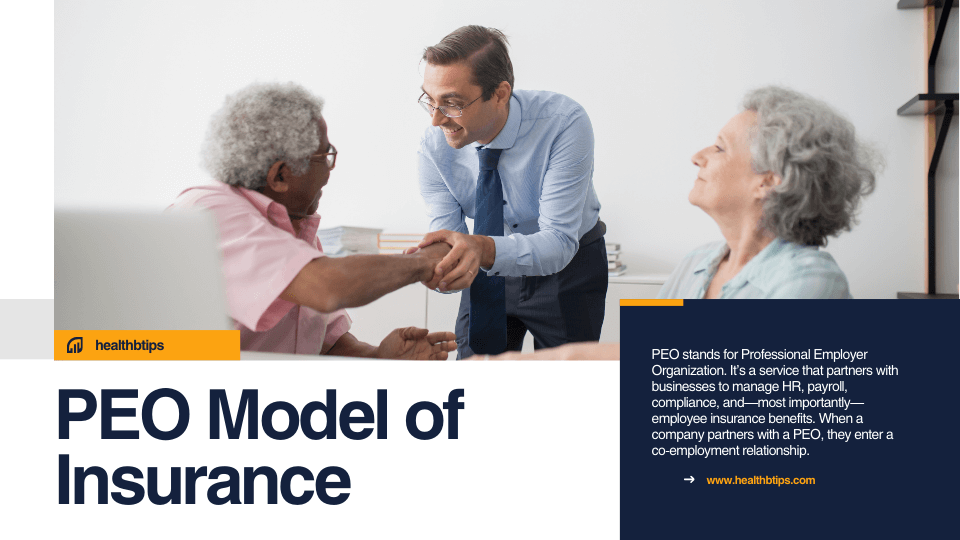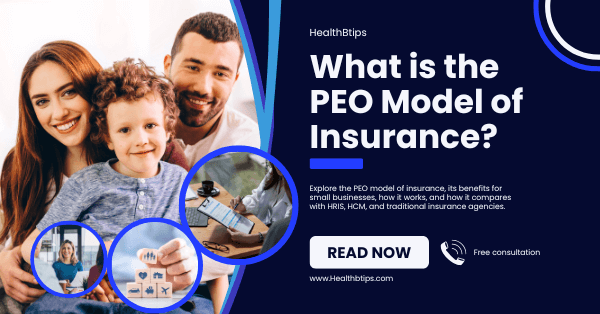A Complete Guide for Business Owners
In today’s fast-moving business world, managing HR tasks like payroll, employee benefits, and insurance can be overwhelming—especially for small and mid-sized businesses. That’s where the PEO model of insurance comes into play. But what exactly is it, and how can it help your company grow more efficiently?
Let’s break it down in simple terms.
What Does PEO Stand For?
PEO stands for Professional Employer Organization. It’s a service that partners with businesses to manage HR, payroll, compliance, and—most importantly—employee insurance benefits. When a company partners with a PEO, they enter a co-employment relationship.
This means the PEO becomes the “employer of record” for tax and benefits purposes, while you (the business owner) retain control over day-to-day management and operations.
What is the PEO Model of Insurance?
The PEO model of insurance allows businesses to offer affordable, high-quality insurance plans to their employees—plans they may not otherwise have access to. Because a PEO pools together employees from many small businesses, they can negotiate better insurance rates from providers, similar to what large corporations get.
Typical insurance services include:
- Group health insurance
- Workers’ compensation insurance
- Disability and life insurance
- Unemployment insurance management
- Liability coverage

How Does the PEO Model Work?
Here’s a simple step-by-step explanation of how the PEO model works:
- Co-Employment Agreement
You sign a legal agreement that splits responsibilities: the PEO handles HR, benefits, and compliance, while you handle business operations. - Employee Enrollment
Your team is enrolled in the PEO’s insurance plans, gaining access to group rates and benefits. - Payroll and Compliance
The PEO manages payroll processing, tax filings, and ensures you comply with labor laws and insurance regulations. - Ongoing Support
You get dedicated support for HR issues, insurance claims, onboarding, and risk management.
What Are the Three Types of PEO?
While “PEO” is often used broadly, there are a few variations in the outsourcing space:
- Traditional PEO – Full-service co-employment model (HR, payroll, insurance, compliance)
- ASO (Administrative Services Only) – You stay the employer of record; the provider only handles admin tasks
- HRO (Human Resource Outsourcing) – Focuses mostly on recruitment, talent, and HR tasks; less involvement in insurance
How is a PEO Different from an Insurance Agency?
Here’s a quick comparison
| Feature | PEO | Insurance Agency |
|---|---|---|
| Employer of record | Yes | No |
| Handles payroll/HR | Yes | No |
| Group insurance access | Yes (shared across clients) | No (you buy standalone plans) |
| Compliance support | Yes | Limited or none |
So, a PEO is more comprehensive—offering bundled HR services along with insurance solutions, unlike agencies that sell policies only.
What is the Goal of a PEO?
The main goals of a PEO are:
- To reduce HR and insurance burdens
- To offer affordable employee benefits
- To ensure legal compliance
- To streamline payroll, onboarding, and administration
This makes them highly attractive to startups and small businesses that want to scale without hiring large HR teams.
What is the PEO Model in Practice?
Imagine you run a growing digital agency with 15 employees. You want to offer health insurance but can’t afford corporate-level plans. By partnering with a PEO:
- Your team gets great coverage at better rates
- Payroll and taxes are handled professionally
- You stay focused on running your business
It’s like having an expert HR department—without the overhead.
What is PEO vs HRIS vs HCM?
- PEO – Outsourced HR partner that takes on legal responsibility and provides bundled services (HR + Insurance)
- HRIS (Human Resource Information System) – A software system used to manage HR data, not an external provider
- HCM (Human Capital Management) – A broader term that includes talent management and HR strategy
PEOs provide services, while HRIS/HCM are tools or systems.
Is the PEO Model a Frame of Reference?
In some fields like occupational therapy, “PEO” stands for Person-Environment-Occupation—a totally different model used to assess individual function. It’s unrelated to HR or insurance, though both use the same acronym.
What is the PEO Model for Autism?
Similarly, in therapy or developmental contexts, the PEO model refers to how a person (like a child with autism) interacts with their environment and daily activities. Again, this is different from the business/insurance context.
Benefits of the PEO Model for Insurance
- Access to premium benefits at affordable rates
- Legal and tax compliance support
- Reduced administrative workload
- Centralized HR and payroll processing
- Professional risk management
Should You Use a PEO?
If you’re a business owner struggling with employee benefits, compliance, and HR admin, a PEO could be a game-changer. It’s not just about saving money—it’s about saving time, reducing risk, and keeping your employees happy and protected.
Before choosing a provider, compare PEOs carefully, check reviews, and ensure they’re IRS-certified and transparent about fees.
FAQs
Q: Is a PEO good for small businesses?
Yes. PEOs help small businesses access better benefits and reduce HR burdens.
Q: Can a PEO save money on insurance?
Often, yes—thanks to group plan pricing and risk pooling.
Q: Are PEOs legal and safe to use?
Yes, as long as they’re certified and reputable.
- Link to reputable sources like





